The Harrison family of Virginia, primarily consisting of two branches, is a notable political family in U.S. history. The family’s origin is in England ; members of one branch immigrated to Virginia before 1633, settled on the James River, and are occasionally referred to as the James River Harrisons. This branch includes successive generations who served in the colonial Virginia legislature, a signer of the Declaration of Independence, and several Virginia Governors. Also notably descended from the James River family were two presidents of the United States, William Henry Harrison and Benjamin Harrison. The family produced as well two mayors of Chicago , and members of the U. S. House of Representatives. The second branch of the Virginia Harrisons descends from an interim chaplain of the Jamestown Colony, who returned to England. The family later immigrated in 1687, first to New England, and then settled in the Shenandoah Valley of Virginia fifty years later. They include the founder of the city of Harrisonburg, and brought forth another of the nation’s presidents, Abraham Lincoln. This branch also includes noted physicians, educators, and local officials.
- virginia
- jamestown
- harrison
1. English Origins
Genealogists believe the Harrisons were Viking warriors of Norse origin, and that they arrived in England with Canute the Great. Others indicate they are of Norman, Irish and Scottish descent. Many Harrisons are known to have settled in Northumberland, as well as Yorkshire and Durham, all in the northernmost region of England. Though some continued the use of the older spelling—“Harryson” (for "son of Harry")—this ended with their arrival in the New World.
It is readily apparent that the two family lines of Harrison immigrants to Virginia shared very similar coats of arms, both issued in English peerage. They feature helmets and shields, emblazoned by eagle(s) of golden shade, upon a dark field, with supporters. The arms of William Henry Harrison (1773–1841) of the James River Harrisons, depicting three eagles, is mentioned in the arms of "Harrison of the North" granted in England in 1574 as well as those of "Harrison of London" granted in 1613 with a pedigree dating from 1374. It has often been referred to as the “Yorkshire arms.”[1]
A second, like coat of arms, the “Durham arms,” are from the same or earlier age. These were used by Daniel Harrison of the Shenandoah Valley Harrisons, represented by one eagle, and sourced to Harrisons descended from Durham. Included is the crest shoulder “gules” (red) signaling strength/martyrdom. This is established by the pedigree of Robert Harrison in 1630, depicting him as the grandson of Rowland Harrison of Barnard Castle in Durham.[1]
2. James River Family
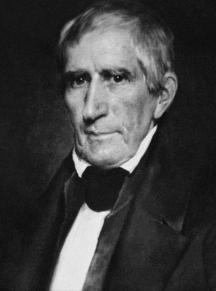
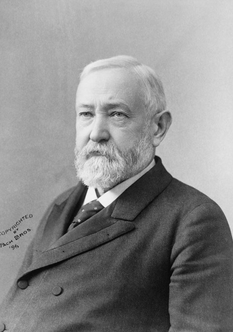
Among the First Families of Virginia, the James River Harrisons came to the Colony of Virginia in 1630 when Benjamin Harrison I (1594–1648)[2] (the first of many to bear that name) left England for the Americas. Benjamin had three brothers, Richard, Edward and Thomas, who followed him, but took different routes. No records have been found to provide earlier definitive genealogy, but a couple of traditions persist. There is one tradition holding that the family may have migrated by way of the West Indies. The father of these brothers is said by one source to be Richard Harrison, who descended from the above Rowland Harrison of Durham.[3] Another tradition, not adequately sourced, indicates the brothers may have been the sons of Thomas Harrison, Lord of Gobion's Manor (1568–1625) and Elizabeth Bernard (1569–1643) of St. Giles, Nottinghamshire, England.
In any case, Benjamin's brother Richard settled in Connecticut. Brother Edward was in Boston. A third brother, Rev. Thomas Harrison (1619–1682), arrived in Virginia in 1640, and was the minister at Elizabeth River Parish.[1] It is likely that Thomas later became the ancestor of the Shenandoah Harrison family referenced below.
The first Benjamin Harrison was certain to have arrived by 1633 when he was installed as Clerk of the Virginia Governor's Council. In 1642 he became the first of the clan to serve as a legislator, in the Virginia House of Burgesses.[4] For more than two centuries afterwards the Harrisons played a noteworthy role in American political history.[5]
His son, Benjamin Harrison II (1645–1712), served as County Sheriff, and in the House of Burgesses as well, and also was appointed to the Governor's Council, the upper house of the Colony’s legislature.[6] It should be noted that none of the successive Benjamins used the numerical suffix—this has become a convenient tool for historians in distinguishing them.
The second Benjamin in turn fathered Benjamin Harrison III (1673–1710), who similarly was drafted for public service and power, as acting attorney general, then Treasurer of the Colony and member as well as Speaker of the Burgesses. He famously made acquisition of Berkeley Hundred on the James River.[7]
Benjamin Harrison IV (1693–1745) became a member of the House of Burgesses, but did not otherwise pursue politics. He notably married Anne Carter (1702–1745), daughter of Robert “King” Carter (1662/63– 1732), and built the family homestead, Berkeley Plantation.[8]
2.1. The “Signer” and Two Presidents
His son, Benjamin Harrison V (1726—1791), is known in modern times in the family as “the Signer” of the Declaration of Independence, representing Virginia in both the First and Second Continental Congresses. He also served in the House of Burgesses and later as Governor of Virginia. He was a rather corpulent and boisterous man by Puritan standards (John Adams referred to him as the Congress' "Falstaff.") A quote is attributed to Harrison—as he was about to put his signature to the Declaration, he turned to his fellow signatory, Elbridge Gerry of Massachusetts, and said, "I shall have a great advantage over you, Mr. Gerry, when we are all hung for what we are now doing. From the size and weight of my body I shall die in a few minutes and be with the Angels, but from the lightness of your body you will dance in the air an hour or two before you are dead."[9]
“The Signer” had a brother Nathaniel who served as Sheriff of Prince George County and also in the House of Delegates; Nathaniel's son Edmund served as Speaker in the House.[10]
Benjamin Harrison VI (1755–1799) was a successful businessman and also served in the Virginia House of Delegates. His brother was General William Henry Harrison who served as a congressional delegate for the Northwest Territory, was appointed in 1800 as Governor of the Indiana Territory, and also served in the War of 1812.
The general, representing the Whig party, defeated incumbent Martin Van Buren in the 1840 presidential election, but fell ill and died just one month into his presidency. Vice-President John Tyler, fellow Virginian and Berkeley neighbor, succeeded him. William Henry was the father of John Scott Harrison, an Ohio congressman.
John Scott Harrison (1804– 1878) was the father of Benjamin Harrison (1833–1901), a Brigadier General in the Union Army during the Civil War. Benjamin also served in the United States Senate, became the Republican candidate for president in 1888, and defeated incumbent Grover Cleveland. John Scott Harrison then became the only person who was the son of one president and father of another.
3. Harrisons in the Shenandoah Valley
The Harrisons who settled in the Shenandoah Valley a hundred years later came from New England, but had common ancestry with the James River family. As referenced above, this family descends from Benjamin Harrison I's brother, Rev. Thomas Harrison. In addition to leading his parish at Elizabeth River, at age 21, young Thomas was appointed by Governor Berkeley as an acting chaplain of the Jamestown Colony during his time in America.[1]
Thomas was a native of Kingston-upon-Hull, Yorkshire. Records from Trinity College indicate he received his Doctor of Divinity degree there. After arriving in Virginia, however, he became a Puritan and soon thereafter left his parishes following the Indian Massacre at Jamestown. He journeyed to Boston, home of brother Edward as well as many Puritan brethren. He then married Dorothy Symonds, and repatriated to England. In 1650 he had a parish at St. Dunstan-in-the-East, London, joining the English nonconformist counterparts of the Puritans. In 1655, then a widow, he became the Chaplain for Henry Cromwell, accompanied him to Ireland as a nonconformist, and resided with the Cromwells. In 1659 he remarried, to Katherine Bradshaw, and for a time resided in Chester. He later settled in Dublin and in 1666 most likely fathered a son Isaiah, who is known to be the patriarch of the Virginia Harrisons of the Shenandoah Valley. Thomas died in Dublin in 1682.[1]
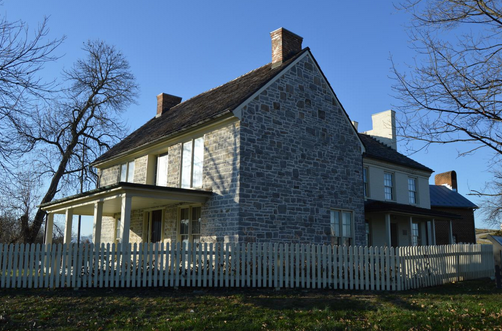
Some have contended that the Valley Harrisons instead descended from Major General Thomas Harrison (1606–1660), who was not only a contemporary of Rev. Thomas Harrison, but whose wife was also named Katherine. The General famously participated in the regicide of King Charles I, and was in 1660 therefore hanged, drawn, and quartered. The Reverend’s position as a nonconfomist likely made them allies as respects the monarchy, which added to the confusion of their identities. No record of a pedigree and succeeding coat of arms for the General’s family is found at the Herald's College, as in the case of the Reverend. Also, no other lineage to the General has been adequately shown, and it is therefore mostly discredited.[11]
3.1. Isaiah and Another President
The strongest evidence, though circumstantial, is that Rev. Thomas Harrison was the father of Isaiah Harrison (1666–1738), who was born in Dublin at the time of Thomas’ residence there. Thomas’ use of the name Isaiah for his son was both distinctly innovative in the family, and also consistent with his Puritan and nonconformist belief. Isaiah in 1687 sailed from there for New York, most likely on the ship The Spotted Calf—his departure, upon his maturation several years following his father’s death, was also a consequence of his father's position as a nonconformist. In America, the Congregational church was the counterpart to the nonconformist movement in England and Ireland. Indeed, Isaiah's own loyalty to nonconformism is known from the Congregational church he joined after his arrival in New England, where Congregationalists were most visible. Also, records in Dublin show Thomas’ consistent spelling of Harrison with the double “s”—not generally found to be the case in England. Isaiah and his children later utilized the same spelling in their American court records, including the ultimate ones in Virginia. [1][12]
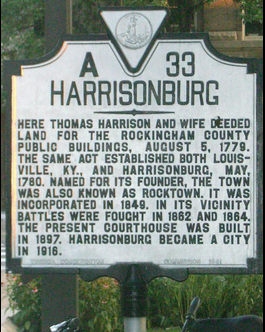
Isaiah Harrison is shown at Oyster Bay on Long Island in 1687—the region from which his father Thomas departed on his return to England. There are frequent and mutual family references at that time between Isaiah’s family and the family of Richard Harrison across the Long Island Sound in nearby New Haven, Connecticut. Richard, who arrived in Connecticut in 1644, again was a brother of the first Benjamin as well as Rev. Thomas, and therefore was Isaiah’s uncle. Two other Harrisons appear in many coincident records of close proximity in New York in the latter part of the 17th century. John Harrison is shown in Flushing in 1685, and Samuel at Gloucester in 1688.[13][14]
Isaiah’s first wife was Elizabeth Wright, by whom he had five children, before her death in 1698. He remarried to Abigail in 1700, and had five children—four sons, John (1691–1771), Daniel (1701–1770), Thomas (1704–1785), and Samuel (1712–1790), and one daughter Abigail (1710-1780). After living fourteen years at Oyster Bay, Isaiah and family moved to Smithtown near the Nissequogue River, on Long Island, where he remained for nineteen years.[1] In 1721 Isaiah's clan moved to Sussex County, Delaware, where Isaiah acquired the Maiden Plantation. While there, daughter Abigail married Alexander Herring (1708–1780).
From Delaware, the Harrison family in 1737 migrated to the Valley of Virginia via Alexandria, and camped in the Luray area while waiting for their land grants to be finalized. Isaiah died in 1738 and was buried on the banks of the Shenandoah River. The family’s first recorded land acquisition in Virginia was by son Daniel in 1739 in Rockingham County. Daniel and Thomas later founded there the towns of Dayton and Harrisonburg, respectively.[15] Brother John settled at Great Spring and Samuel settled at nearby Linville. Daniel is known to have used the "Durham arms" as his seal for the legal documents in Rockingham.[16]
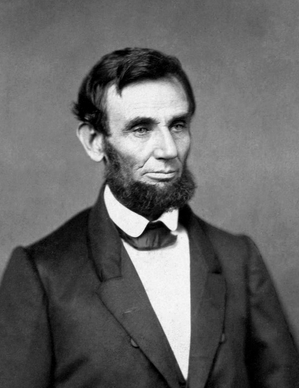
Sister Abigail and husband Alexander Herring settled at Linville also. Their daughter Bathsheba (1742-1836) married Capt. Abraham Lincoln (1744-1786), also of Linville, and they had a son Thomas Lincoln (1778–1851); he in turn married Nancy Hanks (1783–1818). They had a son, Abraham Lincoln (1809–1865) who became President.[17][18] Abraham, who was the Republican candidate for President in 1860, defeated Democrat Stephen Douglas, and as President famously preserved the United States through its civil war before his assassination in 1865.
The Shenandoah Harrisons also include in their descendants a few local officials—Daniel served as a Captain in the French and Indian War, and Deputy Sheriff in Augusta County. Thomas Harrison was qualified as a Lieutenant in that conflict.[19]. The family as well had a number of notable educators and physicians, descendants of Daniel and primarily from the University of Virginia, viz. Peachy Harrison, MD, Gessner Harrison, MD, George Tucker, Prof. Francis H. Smith and wife Mary Stuart Smith, George T. Smith, MD, and J. Hartwell Harrison, MD.[20]
The Shenandoah Valley Harrisons are related to the families of George Washington and Robert Carter I. and others.[21]
4. Legacies
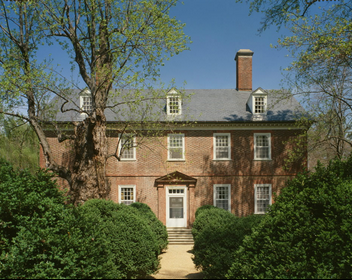
Benjamin IV’s Berkeley Plantation in Charles City County, Virginia, the site in 1619 of one of the first Thanksgivings, was the icon of the Harrison family’s “baronial” status in Virginia. Other historic Virginia homes of the Harrison family include Brandon Plantation, Upper Brandon, Hunting Quarter, The Oaks, The Wigwam, Four Mile Tree and Kittiewan.
Nearby along Virginia State Route 5 and the Virginia Capital Trail, the Benjamin Harrison Memorial Bridge, a major drawbridge across the James River, is named in honor of “the Signer.” The U.S. Army Fort Benjamin Harrison near Indianapolis, Indiana was named for President Benjamin Harrison, who was born in Ohio.
Beyond the city bearing their name in the Virginia valley, the Shenandoah Harrisons are further memorialized by the Harrison Building on the Campus of James Madison University and nearby Fort Harrison in Dayton. There are also memorials at the University of Virginia named for Gessner Harrison, George Tucker, and Mary Stuart Smith.
5. Other Family Notables (Partial List)
Descendants of Benjamin Harrison IV are related to King Edward I of England, due to Benjamin Harrison IV's marriage into the Carter family.
Descendants of Gessner Harrison are related to King George VI due to Gessner's marriage into the Tucker family.
- Reverend Dr. James Blair (1656–1743), born in Scotland, Highest ranking representative of the Church of England in the Colony of Virginia as Commissary of the Bishop of London; he helped found and became First President of the College of William and Mary in 1693, married Sarah Harrison, daughter of Benjamin Harrison Jr. (II).
- Benjamin Harrison VI (1755-1799), son of Benjamin Harrison V, merchant, planter, politician, and revolutionary
- Carter Bassett Harrison (1752–1808), Son of Benjamin Harrison V, member of the Virginia General Assembly, U.S. Representative from Virginia 1793–99.
- Burwell Bassett (1764–1841), First cousin of William Henry Harrison, Virginia House delegate 1787–89 and 1819–21, Virginia state senator 1794–1805, U.S. Representative from Virginia 1805–13, 1815–19, and 1821–29.
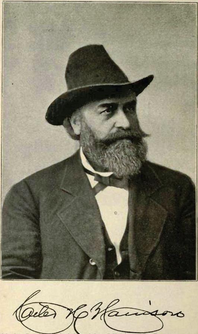
- John Scott Harrison (1804–1878), son of William Henry Harrison, U.S. Representative from Ohio 1853–57
- Alvin Saunders (1817–1899), grandfather of William H. Harrison, delegate to the Iowa Constitutional Convention 1846, Iowa State Senator 1854–56 and 1858–60, delegate to the Republican National Convention 1860 and 1868, Governor of Nebraska Territory 1861–67, U.S. Senator from Nebraska 1877–83.
- Russell Benjamin Harrison (1854–1936), son of President Benjamin Harrison, son-in-law of Alvin Saunders, father of William H. Harrison (U.S. Representative from Wyoming), Indiana Representative 1921–25, Indiana State Senator 1925–33.
- William H. Harrison (1896–1990), son of Russell Benjamin Harrison, grandson of Alvin Saunders and President Benjamin Harrison. Indiana State Representative 1927–29, Wyoming State Representative 1945–50, U.S. Representative from Wyoming 1951–55, 1961–65, and 1967–69, candidate for U.S. Senate from Wyoming 1954.
- Carter Henry Harrison I (1736–1793), ∞ 1760 : Susannah Randolph (1738–1806)
- Carter Henry Harrison III (1825–1893), ∞ 1855 : Sophonisba Grayson Preston (1833–1876); ∞ 1882 : Margaret Stearns (1829–1887)
- Carter Henry Harrison IV (1860–1953), ∞ 1887 : Edith Ogden (1862–1955)
References
- Harrison, pp. 67–105.
- "Benjamin Harrison I". Find A Grave. https://www.findagrave.com/memorial/7656419.
- McConathy
- Dowdey, p. 52
- Dowdey
- Dowdey, p. 98
- Dowdey, p. 115.
- Dowdey, p. 146.
- McNamara, Bruce (2008). "Benjamin Harrison". Society of Descendants of Signers of the Declaration of Independence. http://www.dsdi1776.com/signers-by-state/benjamin-harrison. Retrieved April 11, 2018.
- Hooker, p. 27.
- Harrison, p. 15.
- Hood, p. 449.
- Harrison, pp. 15.
- Harrison, pp. 10–12.
- Harrison, pp. 10, 15.
- Harrison, pp. 128.
- Harrison, pp. 280–286.
- "Ancestry of Abraham Lincoln–Graphic Family Tree". Famous Kin.com. https://famouskin.com/pedigree.php?name=7637+abraham+lincoln&ahnum=1.
- Harrison, pp. 200, 204.
- Harrison, pp. 89, 191, 319, 396, 478, 555.
- Harrison, pp. 223.
